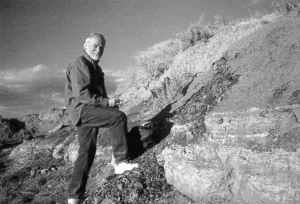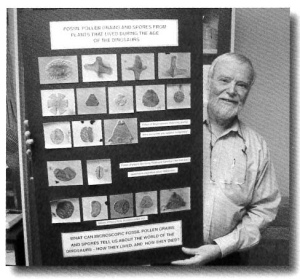Title: In Memoriam: Doug Nichols
Author: Bob Raynolds
Publication: The Outcrop, March 2010, p. 14
Doug Nichols passed away in Longmont on January 21 due to complications from pulmonary embolism.
Doug was a prominent palynologist whose work helped define the character of the Cretaceous/Tertiary boundary event and to establish a pollen biostratigraphy for the Laramide basins of western North America.
Doug was born in Jamaica, Long Island in 1942 and earned his bachelor’s and master’s degrees in Geology at New York University before obtaining his doctorate at Pennsylvania State University. He married Jan Weisbrodt in 1964. Doug and Jan moved to Berthoud, Colorado a few years ago where Jan created a wonderful garden.
After a stint at University teaching, Doug spent his early career in industry, working as a palynologist for Chevron USA. Doug then worked for the U.S. Geological Survey for 28 years in the Lakewood office. Following his retirement from the USGS in 2006, Doug worked as a Research Associate at the Denver Museum of Nature & Science. Doug was a Fellow of the Geological Society of America, past president of the American Association of Stratigraphic Palynologists, editor of Palynology, and editor in chief of Cretaceous Research. Doug wrote a popular science column for his local newspaper.
 Doug traveled widely and presented his research results at meetings world-wide. His meticulous research was published in over 140 articles and books. Doug was gregarious in sharing his insights, and an energetic and companionable collaborator. The fossil pollen grains he studied, while almost invisible to the naked eye, have been proven to provide a reliable dating system for rocks that are otherwise difficult to date and correlate. His studies of pollen evolution revealed abrupt changes associated with the Cretaceous/Tertiary event, observations that corroborate dramatic and contemporary changes observed in other terrestrial floras and faunas, as well as in marine organisms. Taken together with the work of his colleagues this research forms one of the strongest pieces of evidence supporting the asteroid impact hypothesis for the boundary event. Doug also documented and published palynostratigraphic records of the Late Cretaceous and early Tertiary that allow regional subdivision and correlation of non-marine strata throughout the western United States. He will be remembered as a rigorous researcher who tackled problems with a zest and flair, and one who championed the use of multiple working hypotheses to systematically tease Earth’s history from the rock record.
Doug traveled widely and presented his research results at meetings world-wide. His meticulous research was published in over 140 articles and books. Doug was gregarious in sharing his insights, and an energetic and companionable collaborator. The fossil pollen grains he studied, while almost invisible to the naked eye, have been proven to provide a reliable dating system for rocks that are otherwise difficult to date and correlate. His studies of pollen evolution revealed abrupt changes associated with the Cretaceous/Tertiary event, observations that corroborate dramatic and contemporary changes observed in other terrestrial floras and faunas, as well as in marine organisms. Taken together with the work of his colleagues this research forms one of the strongest pieces of evidence supporting the asteroid impact hypothesis for the boundary event. Doug also documented and published palynostratigraphic records of the Late Cretaceous and early Tertiary that allow regional subdivision and correlation of non-marine strata throughout the western United States. He will be remembered as a rigorous researcher who tackled problems with a zest and flair, and one who championed the use of multiple working hypotheses to systematically tease Earth’s history from the rock record.
Doug loved field work, watching the success of his children and relaxing in his wife’s garden. In addition to his wife Jan, Doug is survived by his daughters Joyce and Amber, by his son Ken and by one grandchild.
Doug’s family has asked that donations in his name be made to the Denver Museum of Nature & Science’s palynology research program.
